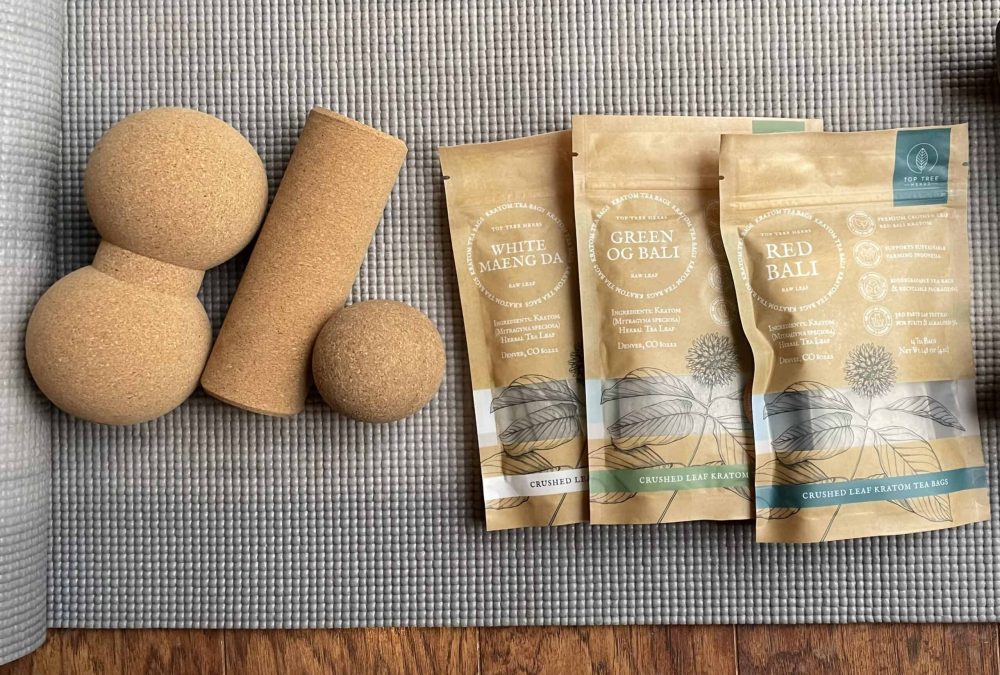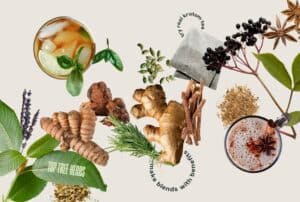The Perfect Post Workout Tea
Why is ginger turmeric kratom tea a great choice for after your daily sweat session? Kratom has long been used for fitness as a pre-workout, and it’s increasingly becoming an established part of post-workout wellness and recovery!
When you think of staying in shape and being healthy, you usually imagine the process as having one important stage: physical exercise. This may be true, to a point, but there are actually two other stages that are just as important!
Three essential aspects of fitness:
- Motivation – energizing yourself to get to the gym
- Exercise – challenging your body and mind to do hard work
- Recovery – soothing sore muscles and supporting your fitness through other healthy habits
Before working out, you need to build up motivation. Following exercise, you need to recover! If you overlook the role of motivation and post-workout recovery, you’ll get less out of your workout than you could. The goal today is helping you avoid this common mistake!
We’ll start by reviewing why these steps are so important for overall wellness, then we’ll share a few ways you can improve your approach with kratom tea.
We recently launched our favorite new post-workout kratom drink — Bali Balance: Turmeric Ginger Kratom Tea Bags. We’ll use research on each of the ingredients in ginger turmeric tea to guide our discussion of why kratom (and kratom herbal blends) are a great choice for post-workout and general wellness.
Ginger Turmeric Kratom Tea Benefits
Ginger turmeric tea is one of the most commonly known home remedies for a range of purposes. Turmeric and ginger are both famous Ayurvedic herbs. Each has been used for various therapeutic and folk medicine purposes.
When combined together, they form a powerful tea that may help with a variety of mild physical imbalances. The peppery taste of this tea is a spicy treat.
Before we get into the unique benefits of ginger turmeric kratom tea blend, let’s review what makes ginger and turmeric special on their own. Bali Balance: Turmeric Ginger Kratom Tea Bags
Quick note: the health benefits discussed below should not be taken as medical advice, and ginger turmeric kratom tea is not intended to treat or cure any medical issues. Always consult your doctor about possible ingredient interactions, especially with other medications.
Ginger Tea
Ginger in and of itself is well known for its stomach-soothing effects. It’s one of the most well-studied herbs and traditional medicines. Plus, it is one of few natural products that is regularly recommended by doctors to patients.
As a food, ginger imparts a strong spicy flavor that beautifully complements other ingredients like lemon or mulling spices. Hailing from Southeast Asia, ginger is a staple in many Asian dishes. Ginger tea is a great way to derive the beneficial effects of ginger, while also savoring its satisfying flavor. The most well-known compound found in ginger is gingerol.
Gingerol is the dominant phenolic compound in ginger. Past research has hinted at ginger being a strong antioxidant agent. Overall, the arguments for adding ginger to your wellness routine are robust. But what about ginger in conjunction with turmeric?
Turmeric Tea
Turmeric tea, either by itself or part of ginger turmeric tea, also has many positive health benefits. For starters, turmeric has been used in traditional and folk practices for centuries. It has been used throughout the Indian subcontinent, Thailand, throughout Southeast Asia, as well as Micronesia and the Pacific Islands.
Turmeric is the rhizome of a tall, reed-like tropical plant (Curcuma longa) with a distinct yellow color. Along with its use in medicine and food, turmeric root is a common dye as well.
The yellow color is imparted by the same active compound that provides most of the wellness effects – curcumin. Curcumin is also found in small amounts in ginger. Chemically confirming the compatibility of the two roots in ginger turmeric tea.
In the limited studies done on curcumin, which are still preliminary and haven’t been conducted in rigorous double blinded, placebo controlled studies approved by the FDA, many promising leads have been found. For starters, curcumin is thought help relieve tension from long strenuous exercise.
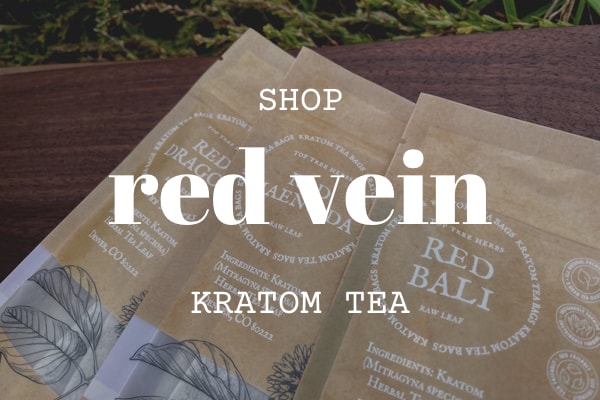
Piperine
That being said, the biggest limiting factor for the possible wellness benefits of curcumin and turmeric is their limited bioavailability. Curcumin is rapidly metabolized by liver enzymes, and so its bioavailability is limited when consumed by itself.
To get the optimal effects from turmeric tea, and thus curcumin, you should take it with something that slows your metabolic process. This in turn allows for more curcumin to work on your body.
One of the ways to achieve this is to take in combination with piperine. Piperine is the main alkaloid in black pepper. It makes curcumin more bioavailable, which means curcumin has a stronger effect.
When consumed together, ginger and turmeric combine to accentuate their best qualities. Each with their own rich and complex flavor, the resulting ginger turmeric tea tastes like the scent of an open air spice market.
Their health benefits are promising, and we wouldn’t be surprised if research in the coming years further elucidates these benefits. Until then, we recommend trying a ginger turmeric tea if for no other reason than the taste!
Best Kratom Strain for Post Workout
- Unwind red vein kratom tea
- Bali Balance ginger turmeric herbal blend
- Chai Unwind red vein kratom tea
- Tulsi Balance peach and mango kratom tea
Our ginger turmeric kratom tea is what we always reach for after a hard workout. Recovery is extremely important after all types of exercise, and isn’t one simple box to check off.
Recovery involves many different processes. It requires proper diet, rest, hydration, and nurturing energy levels to be able to maintain your level of fitness for your next workout.
We picked our classic OG Red Bali crushed leaf kratom tea to go in our recovery blend for a reason. OG Bali is the best kratom strain for a post workout tea because it balances the wide spectrum of kratom effects excellently.
The red bali strain may help you unwind after a long workout. It can also give your mind and body the rest it needs to be able to pick up where you left off the next time you exercise.
Our OG Red Bali kratom strain isn’t known to be too energizing nor too calming. It fits within the middle of the spectrum of kratom’s effects, and makes it possible to drink after both morning and evening workouts.
As half of the blend by weight, kratom is the defining herb in our tea. Consumed as a tea or simply a chewed up leaf, kratom is part of a multi-century long tradition. Kratom culture is primarily situated in Thailand, and radiates throughout Southeast Asia. The leaves are enjoyed by laborers in the day – like coffee – for a productivity boost.
Meanwhile, a stronger kratom tea may also be enjoyed in the evening to unwind and socialize. Our ginger turmeric kratom tea—a earthy Red Bali Kratom Tea Blend—brings these traditions together. All wrapped together and complemented with a variety of tasty and wellness oriented herbs.
Herbal Tea Entourage Effects
The herbal entourage effect is a vague and misunderstood phenomenon. When most people think of the entourage effect, their first thought is of cannabis.
In fact, most conversations regarding the entourage effect explain how the various different cannabinoids, terpenes, and phenolic compounds in cannabis act in combination after consumption.
Basically, the debate is whether or not the combination of these compounds results in an effect different from consuming the main compound, THC, by itself. Do all the compounds together provide a different experience than the individual components would alone?
For example, one compound may shut off a metabolic process. A second compound could then exert an effect that the now-out-of-operation metabolic process would have otherwise have blocked.
This entourage of effects from various components of a plant (or plants) can apply to many more plants aside from cannabis. However, there is limited evidence that the entourage effect is as important as many people claim it is.
Ginger Turmeric Kratom Tea Entourage Effect?
Though there’s limited evidence for the entourage effect in cannabis, there are many parallel phenomena in other areas of natural product chemistry. One area is antioxidants. For example, a single antioxidant may not be beneficial for one’s health when consumed alone.
According to a Harvard School of Public Health article on antioxidants, “One possible reason why many studies on antioxidant supplements do not show a health benefit is because antioxidants tend to work best in combination with other nutrients, plant chemicals, and even other antioxidants.”
Sometimes, you can’t feel the therapeutic effects of a compound unless you pair it with other compounds that you’d find in the first compound’s natural environment.
The study of this phenomenon is incredibly difficult, as plants and natural products contain vast numbers and variable amounts of compounds. Many of these compounds are antioxidants themselves. In the largest studies, the beneficial health effects of the plant consumed whole – as food, not as a concentrated extract/supplement – were not replicable.
To isolate what exactly happens on a biological level is next to impossible. This is because the numerous plant compounds likely cascade and alter the effect that each compound exerts on its own.
Some research has been done regarding plant combinations that do, quite distinctly, have an additive effect. As mentioned earlier, one of the most widely known and utilized plant combinations is black pepper with turmeric – more specifically, the combination of piperine and curcumin.
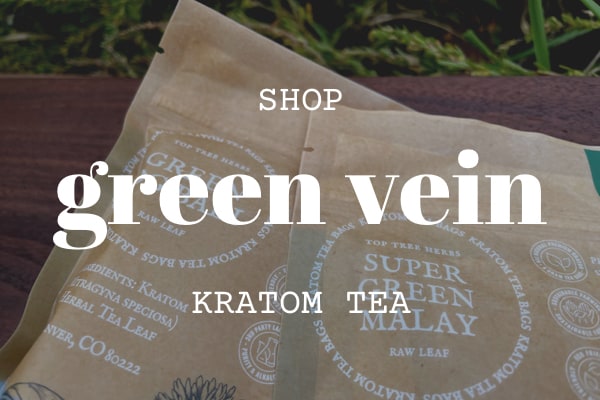
Black Pepper Tea
When you think of tea, black pepper is unlikely to be the first herb or spice you would include in your brew. Pepper has a small but powerful presence.
The alkaloid piperine is responsible for the sharp bite of the pepper. That’s why people usually reserve it for savory dishes. Despite that, black pepper is actually a regular ingredient in herbal teas. Chai tea and chai lattes, for example, often contain a few peppercorns in their spice base.
More than just a way to make the flavors in food pop, black pepper plays an important biological role in how we digest food. Piperine has a complex interaction with our liver enzymes, which affects how those enzymes metabolize other compounds.
Curcumin, the main compound found in turmeric root (as well as one of the compounds found in ginger), has 2000% greater bioavailability when taken with piperine.
Strictly speaking, this is perhaps not an entourage effect, as the partner compounds come from different plants. Nevertheless, this powerful plant synergism is just one of the many beneficial characteristics of our kratom herbal blend.
Cinnamon Tea
Cinnamon is one of the most common spices in our spice cabinets. Aside from knowing it pairs deliciously with sweets, what do you really know about it?
For starters, cinnamon is the dried bark of the cinnamon tree (Cinnamomum cassia). When the bark dries it curls up into its famous cinnamon stick shape.
This bark is rich in polyphenol antioxidants, as well as coumarin compounds. The coumarin compounds and others have been speculated to contribute to its effects, although this has yet to be confirmed outside the lab.
In our tea, cinnamon bark is a flavor accent first and foremost. But like most spices and herbs, it is impossible to divorce their wellness benefits from the flavor. That’s fine with us, and one of the many reasons why we absolutely love tea!
Since there are so many diverse compounds in these natural products, we see drinking herbal tea as akin to taking a multivitamin.
Peppermint Tea
The peppermint in our tea is subtle. The cooling effect from the menthol essential oil in the leaves makes the tongue more sensitive to the collective flavors from the rest of the ingredients. Of course, like most herbs and spices, peppermint exhibits some wellness benefits. These benefits are wide ranging – ranging from easing an upset stomach to being subtly energizing.
That said, the peppermint is present at small levels and is primarily a flavoring agent as opposed to a functional one.
Amalaki Tea
Amalaki, amali, or Indian Gooseberry, is the fruit of the amalaki tree (Emblica officinalis) which grows throughout Southeast Asia. It has an incredibly important place in traditional Ayurvedic medicine. It makes up five of the six essential tastes, called rasas (sour, sweet, bitter, pungent, and astringent).
The only flavor that is lacking is salty. In the Ayurvedic belief system, it is essential to have all six flavors for every meal. Ayurvedic practitioners believe it to have a robust therapeutic potential.
As far as western science is concerned, amalaki is a rich source of vitamins, minerals, amino acids, and other phytochemicals. In fact, one 100 gram serving of amalaki contains as much vitamin C as 20 oranges!
Researchers have shown that amalaki extract has relieving properties in animal models. Yet, they haven’t confirmed these findings in humans. The diverse flavor profile of the Amalaki berry enriches the already spicy and flavorful ginger turmeric tea with red bali kratom.
Most of the ingredients in the tea are flagship herbs of Ayurvedic medicine. The combined flavor has subtle hints of chai and the berry-like flavor of amalaki.
Oregano and Rosemary Tea
The final ingredients in our Bali Balance blend are oregano (Origanum vulgare) and rosemary (Salvia rosmarinus). People don’t often use these herbs in tea. However, they’re extremely nutrient-dense and rich in phenolic compounds. These properties are more than enough to justify their inclusion in our versatile and multifunctional tea.
Oregano has various compounds and oils that may have an effect on our health. Researchers have conducted some preliminary studies of oregano using concentrated doses that are far higher than what would be present in a serving of oregano tea. That said, these studies have had promising results. Researchers will soon be looking into the wellness benefits of oregano at relatively smaller serving sizes.
Rosemary, like oregano, has a long history of purported herbal wellness effects. A member of the sage family, its essential oil contains a number of different phytochemicals which have been the subject of numerous papers.
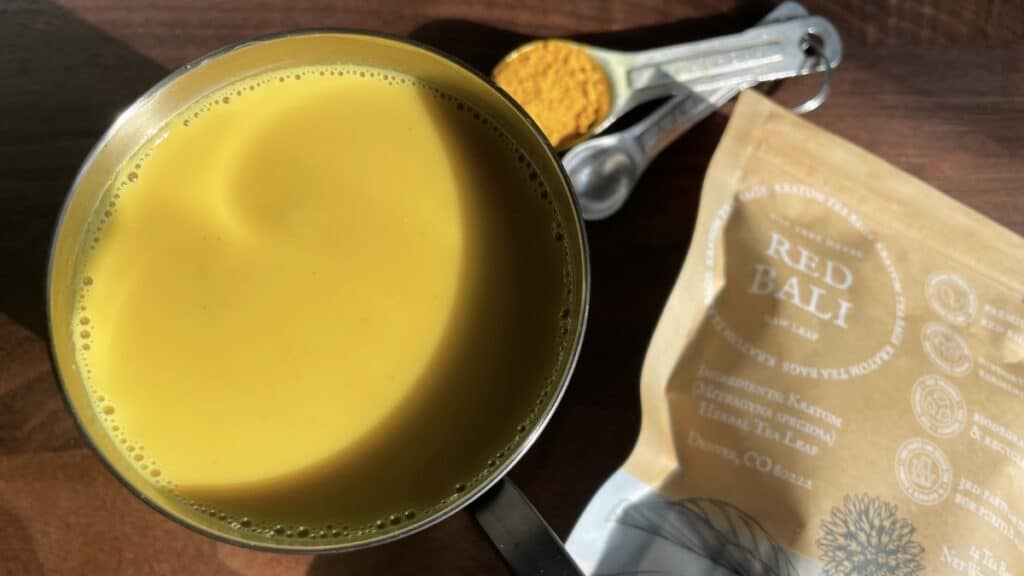
Featured Recipe: Kratom Golden Milk
Kratom Golden Milk
Kratom golden milk tea is a fantastic option for incorporating all of the above herbs and spices into a kratom drink that boasts wellness benefits and great taste. The golden milk uses Red Bali kratom tea as a base. You can easily swap out the kratom and spice mix in the recipe for Bali Balance, which greatly speeds up the process.
Another benefit of making golden milk? The coconut milk could increase the bioavailability of the spices/herbs in the tea. Curcumin and piperine are fat soluble, so using a base for your tea that has some healthy fats could aid your body in absorbing the beneficial compounds.
Why Ginger Turmeric Kratom Tea?
It’s important to remember most of these ingredients have not gone through double blinded, placebo controlled human studies. We chose them because they all share a rich history in folk and traditional medicine practices for restorative purposes.
But history shows just how easy it is to deceive ourselves on the origin of various phenomena. In short, this tea is not intended to treat, cure, or diagnose any disease or condition.
Asterisk aside, we will stand by our claim of the utmost deliciousness of this tea! It has a rich rose color, and almost tastes like a juice with strong berry notes (thanks amalaki!). The ginger turmeric tea components add a subtle spiciness that develops on the tongue after you have swallowed.
Whether you need to rest from a long day of work, or from a hard workout, you can’t go wrong with our Bali Balance: Turmeric Ginger Kratom Blend!
